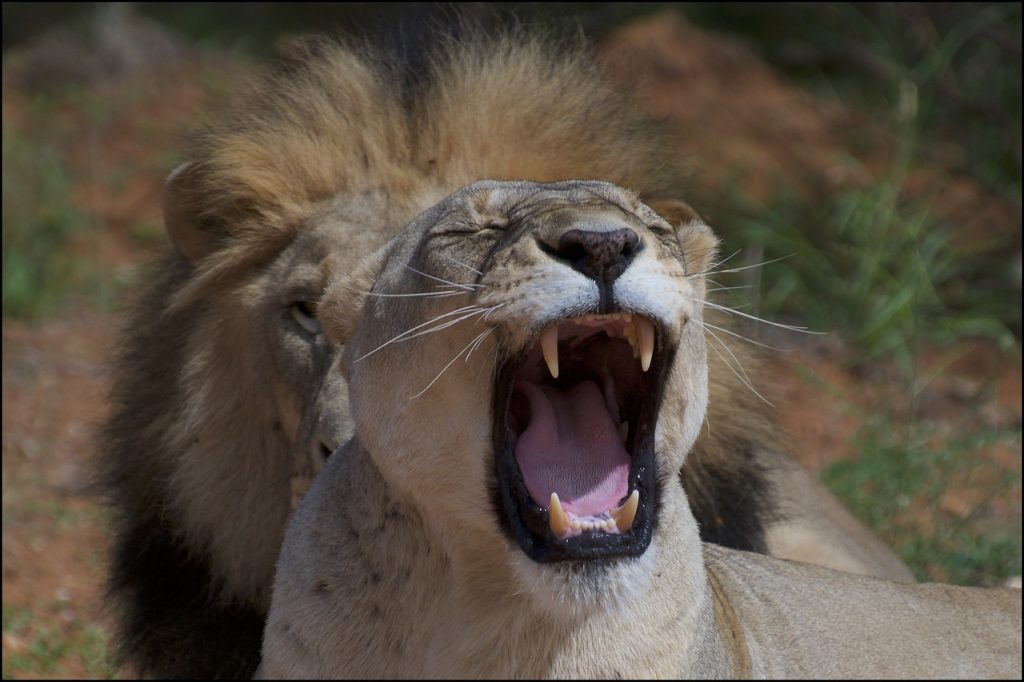In this article, we will explore the fascinating topic of lion behavior in captivity and delve into the valuable insights that can be gained from observing these majestic creatures in zoos and sanctuaries. Lions, known for their strength and regal demeanor, have long been a source of fascination for humans. However, understanding their behavior in captivity has remained a challenge. By studying lions in controlled environments, researchers have been able to shed light on the complexities of their social dynamics, feeding patterns, and overall well-being. Join us as we embark on a journey to unravel the secrets behind lion behavior in captivity and gain a deeper appreciation for these iconic creatures.

Introduction
Keeping lions in captivity requires careful consideration and planning to ensure their health, well-being, and overall quality of life. In this article, we will explore the various aspects of lion management in captivity, discussing topics such as housing and enclosure design, feeding and nutrition, social structure and group dynamics, reproduction and breeding, health and veterinary care, training and enrichment programs, visitor education and experience, conservation and research, as well as the challenges and future directions in captive lion management.
1. Housing and Enclosure Design
Size and layout of enclosures
One of the key factors in providing proper care for captive lions is the size and layout of their enclosures. These enclosures should be spacious enough to allow the lions to exhibit their natural behaviors, including running, pouncing, and climbing. Additionally, the enclosures should be designed in such a way that they offer both open spaces and areas with dense vegetation, providing the lions with opportunities to hide and exhibit their natural hunting instincts.
Enrichment and environmental stimulation
To ensure the mental and physical well-being of captive lions, enrichment and environmental stimulation play a crucial role. This can include a variety of activities and objects, such as puzzle feeders, scent enrichment, and novel toys, that challenge the lions’ cognitive abilities and keep them engaged. Moreover, the inclusion of natural elements like logs, rocks, and grass can further enhance the lions’ environment, replicating their natural habitat and providing opportunities for exploration and play.
Natural habitat replication
Creating an environment that closely resembles the lions’ natural habitat is essential for their overall welfare. This includes replicating the different features found in the wild, such as grasslands, rocky areas, and water sources. By recreating these elements, it allows the lions to engage in natural behaviors, which can contribute to their overall physical and mental health.
Safety measures
In order to prevent injuries and ensure the safety of both the lions and their handlers, it is necessary to implement various safety measures. This includes strong barriers and fencing to prevent escapes, regular inspections and maintenance of enclosures, and standardized protocols for handling and feeding. Additionally, staff members should receive proper training in lion behavior and safety procedures to minimize any potential risks.
2. Feeding and Nutrition
Diet composition
Providing a balanced and nutritious diet is vital for the health and well-being of captive lions. Their diet should consist of a variety of meats, such as beef, chicken, and horse, to ensure they receive all the necessary nutrients. Additionally, organ meats can be included to offer a more complete nutritional profile. It is important to work closely with a qualified veterinarian or animal nutritionist to create a diet plan that meets the specific nutritional needs of the lions in captivity.
Meal timing and frequency
Establishing a consistent feeding schedule is crucial for maintaining the lions’ health and promoting natural feeding behaviors. Lions in captivity should be fed at regular intervals, simulating their natural feeding patterns in the wild. This can help prevent boredom and reduce stress, as well as support proper digestion and metabolism.
Feeding methods and techniques
Various feeding methods and techniques can be employed to provide a stimulating feeding experience for captive lions. This can include scatter feeding, where the food is hidden throughout the enclosure, or food puzzles that require problem-solving skills to access the meal. These techniques can engage the lions’ hunting instincts and encourage physical and mental exertion during mealtime.
Supplemental nutrition
In some cases, supplemental nutrition may be required to ensure the overall health of captive lions. This can include the addition of vitamins, minerals, or specific supplements to their diet. It is important to consult with a veterinarian or nutritionist to determine the appropriate supplements and dosage to meet the lions’ individual needs.
3. Social Structure and Group Dynamics
Formation of social groups
Lions are social animals, and it is important to replicate their natural social structure in captivity. This means providing opportunities for lions to live in groups, either as pairs, prides, or larger social units. Through careful observation and understanding of lion behavior, groups can be formed based on compatibility and social dynamics, promoting a more natural and fulfilling social environment for the captive lions.
Hierarchy and dominance
Within social groups, hierarchies and dominance relationships naturally emerge. It is crucial to recognize and respect these dynamics, as they can influence the lions’ overall well-being. By providing sufficient space and resources, such as feeding areas and resting spots, it allows the lions to establish and maintain their social hierarchy without undue stress.
Social interactions and cooperation
Social interactions and cooperation are integral to the well-being of captive lions. Encouraging positive social behaviors, such as grooming and playing, can help strengthen the bonds within the group and promote a more cohesive social structure. Additionally, providing opportunities for cooperative activities, such as puzzle-solving or shared enrichment, can further foster a sense of camaraderie among the lions.
Separation and reintroduction
At times, it may be necessary to separate individual lions from their social group due to various reasons, such as medical treatment or behavioral issues. When this occurs, careful planning and consideration should be taken to minimize stress and ensure a smooth reintroduction process. Gradual reintroduction with proper supervision and monitoring can help facilitate reestablishing social bonds and reduce the likelihood of aggression or conflict.

4. Reproduction and Breeding
Breeding programs and strategies
Captive lion populations play an important role in conservation efforts, and well-managed breeding programs are crucial for maintaining genetic diversity and preventing inbreeding. These programs require careful consideration of individual lions’ genetic profiles to ensure proper pairing and minimize the risk of genetic abnormalities.
Reproductive behavior and cycles
Understanding reproductive behavior and cycles in captive lions is essential for successful breeding. Close observation and monitoring of female lions’ estrus cycles, as well as male lions’ mating behavior, can help identify optimal breeding times. Additionally, artificial insemination techniques can be employed to enhance breeding success and genetic diversity.
Cub rearing and parenting
Proper cub rearing and parenting techniques are essential for ensuring the healthy development of lion cubs in captivity. This includes providing a safe and enriched environment for the cubs to explore, facilitating opportunities for socialization with their mother and other pride members, and ensuring proper nutrition and veterinary care.
Genetic diversity management
Maintaining genetic diversity within captive lion populations is crucial for their long-term sustainability. This requires careful monitoring of individual lions’ genetic profiles and strategic pairings to minimize the risk of inbreeding. Furthermore, collaboration with other captive facilities and conservation organizations can help exchange lions and introduce new genes into captive populations.
5. Health and Veterinary Care
Regular check-ups and medical examinations
Regular veterinary check-ups and medical examinations are essential to ensure the health and well-being of captive lions. Routine examinations allow for the early detection and treatment of any health issues, as well as the monitoring of overall health indicators, such as body condition and dental health. These check-ups should include vaccinations, parasite control, and dental care.
Disease prevention and control
Preventing and controlling diseases within captive lion populations is of utmost importance. This includes implementing biosecurity protocols to minimize the risk of introducing contagious diseases, as well as regular health screenings and monitoring. In the event of an outbreak, swift and appropriate veterinary interventions, such as quarantine and treatment, should be employed to contain and manage the disease.
Behavioral indicators of health
In addition to physical health, it is essential to monitor the behavioral indicators of health in captive lions. Changes in appetite, activity levels, social interactions, and overall behavior can provide valuable insights into their well-being. Close observation and regular behavioral assessments can help identify any potential health issues or signs of stress and allow for prompt intervention and appropriate care.
Veterinary interventions and treatments
In the event of injuries or illnesses, veterinary interventions and treatments are necessary to ensure the lions’ recovery and well-being. This may include surgeries, medication administration, or specialized treatments for specific conditions. Additionally, veterinary training techniques can be employed to facilitate medical procedures and reduce stress for both the lions and the veterinary staff.

6. Training and Enrichment Programs
Positive reinforcement training methods
Training captive lions using positive reinforcement techniques can be beneficial for their overall well-being and management. By rewarding desired behaviors, such as voluntary participation in medical procedures or exhibiting natural behaviors on cue, it promotes cooperative behavior and reduces stress in handling situations. Positive reinforcement training methods, such as clicker training or target training, can be used to enhance the lions’ mental stimulation and improve their overall welfare.
Behavioral management techniques
Behavioral management techniques are important for addressing any behavioral issues that may arise in captive lions. Positive reinforcement and desensitization techniques can be utilized to modify unwanted behaviors, such as aggression or stereotypic pacing. Consistency in training and behavioral management approaches is key to ensuring the long-term success of these techniques.
Cognitive and physical enrichment activities
Providing cognitive and physical enrichment activities is crucial for the well-being of captive lions. These activities can include puzzle feeders, scent enrichment, or interactive toys that encourage problem-solving and physical exertion. Furthermore, training sessions and interactive playtime with animal care staff can provide additional mental and physical stimulation for the lions.
Training for medical procedures
Training lions to voluntarily participate in medical procedures is vital for their health and welfare. Through positive reinforcement training, lions can be conditioned to tolerate and even cooperate with procedures such as blood draws, vaccinations, or routine health check-ups. This reduces the need for anesthesia or physical restraint, minimizing stress for both the lions and the veterinary staff.
7. Visitor Education and Experience
Interactive exhibits and demonstrations
Interactive exhibits and demonstrations offer visitors a unique opportunity to learn about lions and their behavior. These exhibits can feature informative signs, interactive displays, or live demonstrations that showcase the natural abilities and behaviors of lions. By providing an engaging and educational experience for visitors, it helps raise awareness about the importance of lion conservation and their role in the ecosystem.
Educational programs and talks
Organizing educational programs and talks can provide visitors with a deeper understanding of lions and their conservation needs. These programs can be tailored to different age groups and can cover a range of topics such as lion biology, habitat preservation, and the impact of human activities on wild lion populations. By informing and inspiring visitors, it encourages them to take action and support conservation efforts.
Conservation awareness campaigns
Zoos and sanctuaries have the unique opportunity to raise awareness about lion conservation through dedicated campaigns and initiatives. These campaigns can include social media awareness projects, fundraising events, or collaboration with other conservation organizations. By actively engaging visitors, both on-site and online, it helps mobilize support and promotes a wider understanding of the challenges facing wild lion populations.
Safe and ethical visitor interactions
Ensuring safe and ethical visitor interactions with captive lions is paramount. Zoos and sanctuaries should have strict guidelines in place to protect both the visitors and the lions themselves. This may include physical barriers, trained staff supervision, and enforced rules regarding behavior and animal interactions. By prioritizing safety and respect, it helps foster a positive visitor experience while maintaining the well-being of the captive lions.

8. Conservation and Research
Contribution to wild lion population conservation
Zoos and sanctuaries have an important role to play in the conservation of wild lion populations. Through participation in breeding programs, the exchange of genetic material, and the support of in-situ conservation efforts, captive facilities can actively contribute to the conservation of lions in their natural habitats. By maintaining healthy and genetically diverse captive populations, zoos and sanctuaries can serve as a safety net for future reintroduction programs and support overall conservation goals.
Behavioral studies and research projects
Conducting behavioral studies and research projects on captive lion populations provides valuable insights into their behavior and welfare. These studies can focus on topics such as social dynamics, reproductive behavior, or the impact of environmental enrichment on overall well-being. By better understanding the needs and behaviors of captive lions, management practices can be refined and improved to ensure the best possible care.
Collaboration with conservation organizations
Collaboration with other conservation organizations is crucial for the success of captive lion management programs. This can involve participation in zoological associations, partnering with local and international conservation groups, and sharing knowledge and resources to support common goals. By working together, zoos and sanctuaries can maximize their impact and contribute to a collective effort to conserve and protect lions in the wild.
Information sharing and scientific publications
Sharing information and scientific findings with the wider conservation community is vital for advancing captive lion management practices. Publishing research articles, presenting at conferences, and participating in peer-reviewed journals contribute to the collective knowledge base and allow for continuous improvement in captive lion care. By sharing knowledge and experiences, we can ensure that best practices are implemented across the captive lion management community.
10. Challenges and Future Directions
Rehabilitation and release programs
One of the major challenges in captive lion management is the development of successful rehabilitation and release programs. While this is a complex and multifaceted issue, efforts should be made to explore potential solutions and techniques for reintroducing captive-born lions into the wild. Collaboration with conservation organizations and field experts is pivotal in designing and implementing effective rehabilitation and release strategies.
Addressing captivity-induced behavioral issues
Captive lions may exhibit behavioral issues that are a result of their confinement, such as stereotypic pacing or aggression. It is important to dedicate resources and research to better understand and address these captivity-induced behavioral issues. This includes implementing management strategies that focus on reducing stress, increasing mental and physical stimulation, and providing opportunities for natural behaviors.
Long-term sustainability of captive populations
Ensuring the long-term sustainability of captive lion populations is critical for their conservation value. This requires diligent genetic management, regular assessments of population health and well-being, and active participation in regional and global breeding programs. By maintaining strong and healthy captive populations, zoos and sanctuaries can continue to contribute to the conservation and protection of lions.
Advancements in captive lion management
As scientific knowledge and understanding of lion behavior increase, it is important to continually evaluate and refine captive lion management practices. This includes incorporating new advancements in housing design, dietary requirements, veterinary care, and enrichment techniques. By staying abreast of the latest research and implementing evidence-based practices, we can ensure the highest possible standards of care for lions in captivity.
In conclusion, captive lion management entails a comprehensive approach that considers housing and enclosure design, feeding and nutrition, social structure and group dynamics, reproduction and breeding, health and veterinary care, training and enrichment programs, visitor education and experience, as well as conservation and research. By continuously improving our understanding and practices in these areas, we can better care for captive lions and contribute to the conservation of their wild counterparts.

